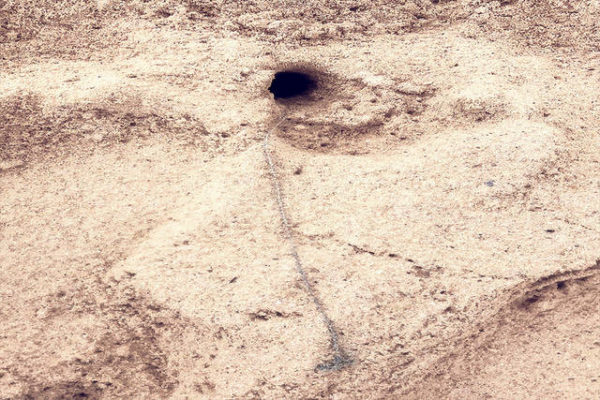Published in the Ocean Watch column, Honolulu Star-Advertiser © Susan Scott
September 8, 2018
We in Hawaii know the blue jellyfish that have been washing ashore in droves on our windward beaches as Portuguese men-of-war. They’re not jellyfish, however, nor are they from Portugal, nor are they men, nor are they warring. Other than that, the name is perfect.
The story goes that British sailors of old thought the floating creatures resembled Portuguese frigates (warships) under sail. Another version is that the ridge on top of the animals’ floats looked like Portuguese soldiers’ helmets.
 An out-of-sight ghost crab on Lanikai Beach is pulling
An out-of-sight ghost crab on Lanikai Beach is pulling
this PMOW tentacle down its hole to eat.
©2018 Susan Scott
Australians went with the simpler name of blue bottle.
Two species float on the surface of the world’s warm waters. The Atlantic and Caribbean species is huge, its float growing to 12 inches long with stinging tentacle up to 160 feet long. People have died after getting tangled in this species.
Our Pacific and Indian oceans species is smaller, its bubble about 2 inches long with a trailing tentacle up to 30 feet long. This species can cause a painful sting, but it’s rarely medically dangerous.
The animals are superb sailboats. Like monohulls, PMOWs are bottom-heavy, so even if the air-filled float gets knocked sideways, the creature pops back up. Also, like sailboats, the animals can raise and lower a “sail,” the pinkish crest on top of the float, and sail 45 degrees to the wind.
Strong, persistent winds can overpower the little vessels, though, and when a group of them happens to be near land, they get blown ashore.
One reader last week emailed that she found on Kailua Beach 13 PMOWs, all small. Only four were blue; the rest were clear with no “tail.” She wondered, “Are these juveniles who have yet to grow a tail and develop color, or are they a different organism?”
The little bubbles are juveniles of our Pacific species, Physalia utriculus. Floats vary from clear to light blue to purple, colors that camouflage the creatures in offshore waters.
The trailing blue threads below the animals are not tails. They’re stinging tentacles, the creature’s way of catching food. Once a PMOW hits the beach, the creature is doomed to die, but its tentacle can still sting.
When we see clear or blue bubbles on the beach without tentacles, we can thank ghost crabs and mole crabs (sometimes called sand turtles in Hawaii). Both eat beached PMOWs, tentacles and all.
Most biologists (not me) will correct you if you call a PMOW a jellyfish. They also like to explain that each is a colony of four separate individuals: one eats, one reproduces, one stings and one floats. None, though, can live alone. Because PMOWs blur the line between being one multicelled organism and a colony of single-celled organisms, the subject has been debated since the mid-1800s. I go with the former. One is one.
I don’t mind calling PMOWs jellyfish because the PMOW’s scientific name, Siphonophore, isn’t likely to catch on, and both animal types use stinging tentacles to catch live food.
The name Portuguese man-of-war is tough to explain, hard for some people to remember, and the plural is a problem. In calling them blue bottles, the Aussies beat the Brits.